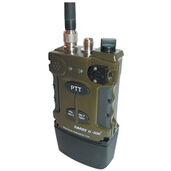An Emergency Beacon is a device designed to assist travellers in distress by summoning assistance. It does this by transmitting a repeating signal on a frequency reserved for that specific purpose. The signal may be a simple pulse designed to help rescuers fix a location, or it may contain information as to whose beacon it is, and the type of assistance - medical or law enforcement - needed. Requesting fire assistance is not ordinarily an option, as nearly all automatic fire-fighting systems include the ability to signal outside authorities in the event the system cannot extinguish the fire itself.
Emergency beacons come in four basic types. Exact details of each type of unit (size, mass, etc) may vary slightly, but they will perform in similar manner.
Personal[]

Personal beacon
A personal emergency beacon is designed for use on developed worlds. It accesses a planet's chronocom or S-CoN network to send it's signal. In analog mode, it has about the same range as a standard chronocom.
A personal beacon consists of a device roughly 6 cm x 3 cm x 1 cm. Some high- end chronocoms have a beacon chip pre-installed taking advantage of the device's own transmitter and location-fixing abilities, eliminating the need to carry a separate unit. It's power source will last for 10 hours continuous use before exhaustion.
- Separate unit - 50 Cr Mass: ---
- Beacon chip - 25 Cr Mass: n/a
Survival[]

Survival beacon
Survival emergency beacons, more commonly referred to as simply "survival beacons", are larger units designed to be carried by individuals engaged in potentially dangerous activities in remote areas. Survival beacons are a normal part of higher-quality survival kits. They are also issued to military pilots as part of their survival gear. Unlike a personal beacon, it only sends a single type of signal, as Search and Rescue teams typically consist of both military/law enforcement and medical personnel.
Survival beacons consist of a unit roughly 16 cm x 8 cm x3 cm (not including antenna), and can transmit for 100 hours before needing to have the power source recharged/replaced. Recharging the power source can easily be done by a small solar converter which also is a normal part of better survival kits. It's range is about half that of a radiophone (500 km, enough to be picked up in low orbit).
- Survival beacon - 500 Cr Mass: --
Vehicle[]

Vehicle Beacon
A vehicle emergency beacon is ordinarily built into the systems of said vehicle. The typical use of such beacons is aboard aircraft, though they may be purchased for other vehicles as well. Vehicle beacons ordinarily transmit a specific signal to tell responders exactly which aircraft it belongs to, similar to the regular beacon incorporated into the communications system for identification purposes.
Vehicle beacons are built more robustly than personal and survival beacons as they are most commonly activated to allow recovery of vehicle data recorders in the event of a crash. The armored casing is roughly 30 cm x 18 cm x 10 cm. It can be picked up at longer ranges as well (roughly equal to a radiophone [1,000 km]). Like the survival beacon, it's power source is good for about 100 hours.
- Vehicle beacon - 700 Cr Mass: 10kg
Spaceship[]

Ship beacon
A spaceship emergency beacon, also known as a "disaster beacon", is a unit incorporated into spaceships, starships, lifeboats, and escape pods. Beacons installed in ships that never leave their home system have beacons that transmit only on conventional frequencies. Beacons installed aboard starships (including their lifeboats and escape pods) are required by interstellar regulations to be subspace capable, and are therefore many times more expensive.
The beacon's transmitter is automatically updated after each Void jump with the stellar co-ordinates of the nearest known planet with subspace communications capability. Upon activation, the beacon automatically orients its antenna towards that destination. This assumes that the jump was accurate. If the jump was not accurate, then the ship's astrogator must update the data manually after calculating the ship's position. Otherwise the beacon will default to the last known "good" co-ordinates.
Neither type are designed to be removed from their respective craft, as they are hooked into on-board power supplies (usually the auxiliary batteries) to operate. The transmitters alone, should they be removed, take up about 3/4 of a cubic meter of space and weigh 100 kg. The battery power allocated to disaster beacons is good for 1,000 hours. If disconnected from the ship/pod, or if the reserve power banks are damaged/destroyed, the amount of transmission time will be limited to whatever amount of power the survivors can scrounge or generate.
- Spaceship beacon - 22,500 Cr Mass: 100 kg (transmitter only)
This article by ChrisDonovan. All images are of commercially available equipment with photoshop mods by me.